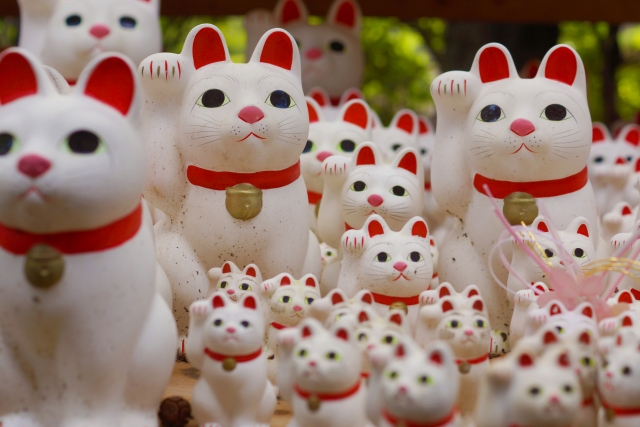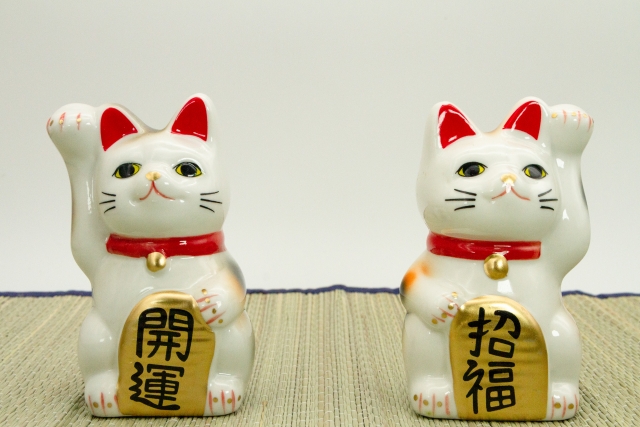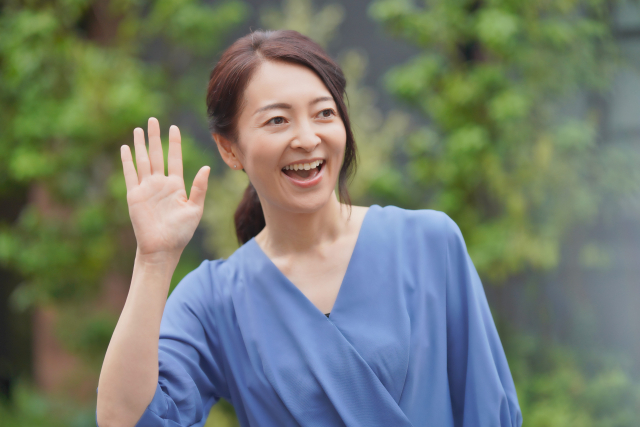The beckoning cat, along with its cute character, is very popular as a symbol of good luck and good fortune.
It seems to be widely accepted not only by the Japanese but also by foreigners.
At Senso-ji temple in Asakusa, Tokyo, which attracts many foreign tourists, you will often see foreigners holding beckoning cats in their hands at souvenir stores along the approach to the temple.
There are two types of beckoning cats, one with its left hand raised and the other with its right hand raised, each with its own meaning.
In this page, we will check their meanings and also look at the origin of beckoning cats.

Click here to learn Japanese language with the best one-on-one Japanese tutoring lessons in person or online.
Contents
What is a beckoning cat?
A beckoning cat is a lucky ornament that is said to “invite good fortune,” and many have been installed in the hope that they will bring prosperity to business.
Today, many are produced in Tokoname City and Seto City in Aichi Prefecture and Takasaki City in Gunma Prefecture.
The ones in Tokoname and Seto are made of ceramic, while the ones in Takasaki are made of papier-mâché, the same material used for Daruma dolls.
In addition, plastic ones have also become available.
White, black, and red are the traditional colors, and in recent years gold, blue, and pink have also been used.
Based on the traditional white cat, black cats are believed to ward off evil and evil spirits, while red cats are believed to ward off disease.
September 29 of every year is “Manekineko Day,” which is named after “Kurufuku,” or “coming good fortune.
This day was established by the Manekineko Club of Japan.

What is the origin of the beckoning cat?
There are many temples and shrines that claim to be the birthplace of beckoning cats, and there are several theories about the origin of beckoning cats.
Here are some of the most famous ones, along with their legends.
Gotokuji Temple’s Manekineko (beckoning cat)
Gotokuji Temple is located in Setagaya Ward, Tokyo, and is sometimes called the “cat temple.
In the Edo period (1603-1867), when Ii Naotaka, a feudal lord of the Hikone domain, passed by Gotokuji Temple (Kotokuji Temple), a white cat kept by a monk in front of the temple gate seemed to beckon to him.
As Naotaka entered the temple, rested and listened to the monk’s story, there was a strong evening shower and a violent lightning strike.
Naotaka, who escaped getting wet, took this opportunity to take refuge in the temple and made Gotokuji his family temple, donating a large sum of money to the temple.
When the cat died, the monk erected a grave to mourn its passing. Later, beckoning cats were made in the shape of a beckoning cat.
There is also a manekineko with its left hand raised.
Imado ware manekineko (beckoning cat)
In the Edo period (1603-1867), an old woman living in Asakusa had to give up her cat due to poverty.
One night, the cat appeared to her in her dream and told her that she would receive good fortune if she made a doll in its image.
These were called “marushimekineko,” and some of them are still in existence.
Marushimekineko have the meaning of “to close the circle of good fortune and money.
Jishoin’s beckoning cat
Jishoin Temple is located in Shinjuku Ward, Tokyo.
When Dokan Ota, a general in the Muromachi period (1336-1573), lost his way during a battle, a cat appeared and beckoned him to come to Jishoin.
Dokan was able to reverse the situation and dedicated the cat Jizoson to Jisei-in Temple.
Later, the beckoning cat was established based on the cat Jizoson.

The beckoning cat at Musho Horin-ji Temple, Genjidan-oin
The Indian beckoning cat is located at Sendan-oin Mujo Horin-ji Temple in Kyoto City, Kyoto Prefecture.
The temple is dedicated to “Shuya-jin,” a god who presides over the night, and his messenger is believed to be a black cat.
In the Edo period (1603-1867), it is said that beckoning cats with their right hand raised were made, and their original color is said to have been either black or green.
What is the meaning of the beckoning cat’s hand?
Meaning of the left hand
When the left hand is raised, the cat is said to be benevolent, inviting people, and attracting customers.
This is why the expression “Senkaku Banrai” is often used.
It is said that during the Edo period (1603-1867), only beckoning cats with their left hand raised were made in the private sector.
Meaning of the right hand
When the right hand is raised, it is said to invite good fortune or to bring good luck.
This good fortune is mainly considered to be related to money, and expressions such as “kinzoku wo shakuyaku” are often used.
Many of the beckoning cats handled by temples and shrines have the right hand raised.
What about both hands?
Traditionally, only beckoning cats with either the left or right hand raised were available.
In recent years, beckoning cats with both hands raised have come to be made to symbolize both “ten thousand visitors” and “bring good fortune.
However, there are many people who dislike these beckoning cats because they are considered to be “otei-no-Manzai” or “greedy.

Placement of the beckoning cat
It is desirable to place the beckoning cat on an Engidana (shelf for good luck) under a Shinto altar, along with other lucky charms and other items.
However, it may not always be possible to set up an Engidana.
In stores, you often see them placed next to the cash register.
Manekineko in the U.S.
The English term “beckoning cat” may be a bit too literal.
Other ways to describe beckoning cats are as follows.
- lucky cat
- fortune cat
- welcome cat
- dollar cat
The beckoning cat is also very popular in the U.S., and is made as souvenirs and for export.
However, the direction of the hand is the opposite of that in Japan, and the back of the hand is visible when facing the beckoning cat.
This is because the gesture used when beckoning is American.

Conclusion
- The beckoning cat is considered a lucky charm that brings good fortune.
- If the left hand is raised, it is said to invite benevolence and people.
- If the right hand is raised, it is said to invite good fortune.
- The preferred form of the beckoning cat is to place it on the blessing shelf below the kamidana.
- For more information on lucky animals and foods, please click here.
Related article:










